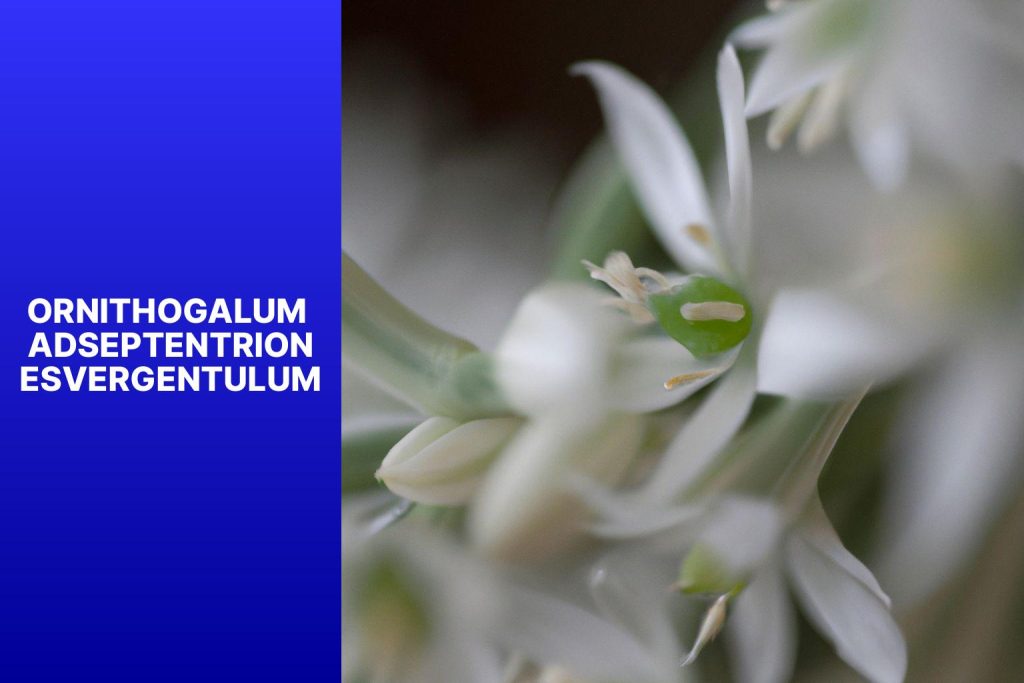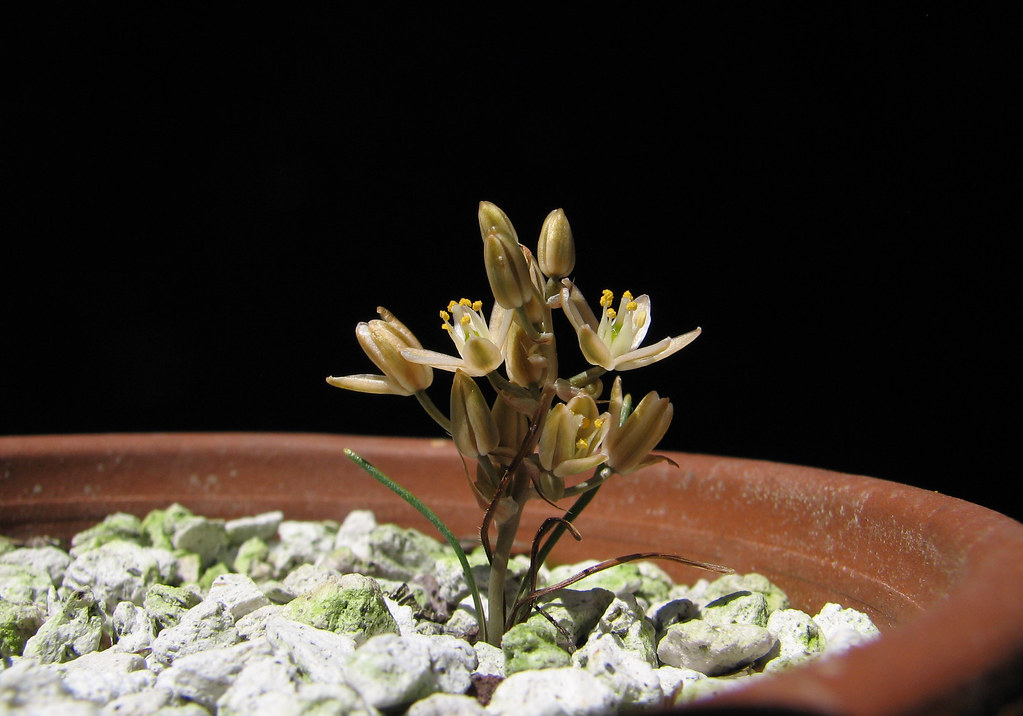The specific epithet “adseptentrionesvergentulum” means “inclined towards the north”, referring to the fact that the flowers of this species tend to face north. The plant is also known by the common name “Small Star of Bethlehem”.

Characteristics of Ornithogalum Adseptentrionesvergentulum
Ornithogalum adseptentrionesvergentulum is a species of flowering plant in the family Asparagaceae, native to the Cape Provinces of South Africa. This monocot from the Great Karoo desert is one of the world’s smallest bulb species, at under 3 cm (1.2 in) tall, and yet it has the longest valid plant name.
Ornithogalum adseptentrionesvergentulum is a small, white flower with a star-shaped appearance. It is native to the Cape Provinces of South Africa and is one of the smallest bulb species in the world. The flowers bloom in late winter or early spring and are borne on a short stalk.
Table of Contents
Ornithogalum adseptentrionesvergentulum is a winter grower, and its flowers bloom in late winter or early spring. The flowers are small and white, with a star-shaped appearance. They are borne on a short stalk, and they typically open sequentially.
The plant is a member of the lily family, and it is related to other plants such as daffodils, lilies, and snowflakes. It is a popular garden plant, and it is also used in herbal medicine.
Here are some interesting facts about Ornithogalum adseptentrionesvergentulum:
- It is the smallest bulb species in the world.
- It has the longest valid plant name.
- Its flowers tend to face north.
- It is a popular garden plant.
- It is used in herbal medicine.
If you are looking for a unique and interesting plant to add to your garden, Ornithogalum adseptentrionesvergentulum is a great option. It is a small and delicate plant, but it is also very hardy and easy to care for. With its beautiful flowers and interesting name, this plant is sure to be a conversation starter.

More Tips For Caring For Ornithogalum Adseptentrionesvergentulum
Ornithogalum adseptentrionesvergentulum is a relatively easy plant to care for, but it does have some specific requirements. Here are some tips for growing Ornithogalum adseptentrionesvergentulum in your garden:
- Planting: Plant the bulbs in the fall, 2-3 inches deep. The bulbs should be planted in full sun or partial shade. The soil should be well-drained.
- Watering: Water the bulbs regularly, especially during the growing season. The soil should be kept moist but not soggy.
- Fertilizing: Fertilize the bulbs once a year with a balanced fertilizer.
- Winter protection: In cold winter areas, the bulbs may need to be protected from frost. You can do this by covering the bulbs with a layer of mulch or by planting them in a pot that can be brought indoors during the winter.
- Propagation: Ornithogalum adseptentrionesvergentulum can be propagated by division or seed. Division is the easiest method. To divide the bulbs, simply dig up the bulbs in the fall and separate them. Replant the divided bulbs immediately.
With proper care, Ornithogalum adseptentrionesvergentulum will thrive in your garden and provide you with beautiful flowers for many years to come.
Here are some additional tips for growing Ornithogalum adseptentrionesvergentulum:
- Deadhead the flowers: Once the flowers have faded, deadhead them to encourage more blooms.
- Protect from slugs and snails: Slugs and snails can be a problem for Ornithogalum adseptentrionesvergentulum. You can protect the plants from slugs and snails by using slug bait or by placing copper tape around the base of the plants.
- Enjoy your flowers! Ornithogalum adseptentrionesvergentulum is a beautiful plant that will add a touch of elegance to your garden. Enjoy the flowers while they last!
Medical Uses Of Ornithogalum Adseptentrionesvergentulum From History To Present
Ornithogalum adseptentrionesvergentulum is a small, white flower that is native to South Africa. It has been used in traditional medicine for centuries, and some of its medicinal uses include:
- Treating respiratory problems: The plant has been used to treat coughs, colds, and asthma.
- Reducing inflammation: The plant has been shown to have anti-inflammatory properties, and it can be used to treat conditions such as arthritis and gout.
- Boosting the immune system: The plant contains antioxidants that can help boost the immune system.
- Protecting the liver: The plant has been shown to have hepatoprotective properties, and it can help protect the liver from damage.
- Releasing stress: The plant has been shown to have relaxing properties, and it can be used to help relieve stress and anxiety.
However, it is important to note that there is limited scientific evidence to support the medicinal uses of Ornithogalum adseptentriones vergentulum. More research is needed to determine the safety and efficacy of the plant for medicinal purposes.
If you are considering using Ornithogalum adseptentrionesvergentulum for medicinal purposes, it is important to talk to your doctor first. They can help you determine if the plant is safe for you to use and advise you on the proper dosage.
Damages And Symptoms Of Ornithogalum Adseptentrionesvergentulum
Ornithogalum adseptentrionesvergentulum is a poisonous plant. All parts of the plant, including the bulbs, leaves, and flowers, contain toxic compounds. The toxic compounds in Ornithogalum adseptentrionesvergentulum are similar to colchicines, which are found in other plants such as autumn crocus and meadow saffron.
Symptoms of poisoning from Ornithogalum adseptentrionesvergentulum can include:
- Nausea and vomiting
- Diarrhea
- Abdominal pain
- Dizziness
- Confusion
- Seizures
- Death
If you think you or someone you know has been poisoned by Ornithogalum adseptentrionesvergentulum, it is important to seek medical attention immediately. There is no specific antidote for poisoning from this plant, but treatment may include supportive care such as fluids and electrolytes and medications to control symptoms.
It is important to note that even small amounts of Ornithogalum adseptentrionesvergentulum can be toxic, so it is important to keep the plant away from children and pets. If you have this plant in your garden, it is important to take steps to prevent accidental poisoning. These steps may include:
- Labeling the plant with a warning label
- Keeping the plant out of reach of children and pets
- Discarding any plant material that is not used
If you have any questions about the toxicity of Ornithogalum adseptentrionesvergentulum, please talk to your doctor or a poison control center.